The Anti-Acne and Reduction of Hyperpigmentation Effects of Products Containing Retinol, Niacinamide, Ceramides, and Dipotassium Glycyrrhizinate in Chinese Women
Abstract
1. Introduction
2. Materials and Methods
2.1. Clinical Assessment
2.2. Photo Tracking
2.2.1. VISIA-CR Imaging Procedures
2.2.2. Visioscan® VC 20plus and Sebufix® F 16 Imaging Procedures
2.2.3. Primos CR Imaging Procedures
2.3. Bioinstrumentation Measurements
2.4. Biostatistics and Data Management
3. Results
3.1. Clinical Assessment
3.2. Image Analysis
Skin Acne-Related Indicators
3.3. Bioinstrumentation Measurements
4. Discussion
5. Conclusions
Author Contributions
Funding
Institutional Review Board Statement
Informed Consent Statement
Data Availability Statement
Conflicts of Interest
Abbreviations
| C. acnes | Cutibacterium acnes |
| PIH | post-inflammatory hyperpigmentation |
References
- Tan, J.; Beissert, S.; Cook-Bolden, F.; Chavda, R.; Harper, J.; Hebert, A.; Lain, E.; Layton, A.; Rocha, M.; Weiss, J.; et al. Evaluation of psychological wellbeing and social impact of combined facial and truncal acne: A multi-national, mixed-methods study. Dermatol. Ther. 2022, 12, 1847–1858. [Google Scholar] [CrossRef] [PubMed]
- Bhate, K.; Williams, H.C. Epidemiology of acne vulgaris. Br. J. Dermatol. 2013, 168, 474–485. [Google Scholar] [CrossRef] [PubMed]
- Webster, G. Mechanism-based treatment of acne vulgaris: The value of combination therapy. J. Drugs Dermatol. JDD 2005, 4, 281–288. [Google Scholar] [PubMed]
- Schachner, L.A.; Alexis, A.F.; Andriessen, A.; Berson, D.; Gold, M.; Goldberg, D.J.; Hu, S.; Keri, J.; Kircik, L.; Woolery-Lloyd, H. Insights into acne and the skin barrier: Optimizing treatment regimens with ceramide-containing skincare. J. Cosmet. Dermatol. 2023, 22, 2902–2909. [Google Scholar]
- Shen, Y.; Wang, T.; Zhou, C.; Wang, X.; Ding, X.; Tian, S.; Liu, Y.; Peng, G.; Xue, S.; Zhou, J.; et al. Prevalence of acne vulgaris in Chinese adolescents and adults: A community-based study of 17,345 subjects in six cities. Acta. Derm. Venereol. 2012, 92, 40–44. [Google Scholar]
- Elbuluk, N.; Grimes, P.; Chien, A.; Hamzavi, I.; Alexis, A.; Taylor, S.; Gonzalez, N.; Weiss, J.; Desai, S.R.; Kang, S. The pathogenesis and management of acne-induced post-inflammatory hyperpigmentation. Am. J. Clin. Dermatol. 2021, 22, 829–836. [Google Scholar]
- Tanghetti, E.A.; Kawata, A.K.; Daniels, S.R.; Yeomans, K.; Burk, C.T.; Callender, V.D. Understanding the burden of adult female acne. J. Clin. Aesthetic Dermatol. 2014, 7, 22. [Google Scholar]
- Kraft, J.; Freiman, A. Management of acne. Can. Med. Assoc. J. 2011, 183, E430–E435. [Google Scholar]
- Eimpunth, S.; Wanitphadeedecha, R.; Manuskiatti, W. A focused review on acne-induced and aesthetic procedure-related postinflammatory hyperpigmentation in Asians. J. Eur. Acad. Dermatol. Venereol. 2013, 27, 7–18. [Google Scholar]
- Ak, M. A comprehensive review of acne vulgaris. J. Clin. Pharm 2019, 1, 17–45. [Google Scholar]
- Tanghetti, E.A. Combination Therapy. Cutis 2005, 76, 8–14. [Google Scholar]
- Leyden, J.; Stein-Gold, L.; Weiss, J. Why topical retinoids are mainstay of therapy for acne. Dermatol. Ther. 2017, 7, 293–304. [Google Scholar]
- Ruamrak, C.; Lourith, N.; Natakankitkul, S. Comparison of clinical efficacies of sodium ascorbyl phosphate, retinol and their combination in acne treatment. Int. J. Cosmet. Sci. 2009, 31, 41–46. [Google Scholar] [CrossRef] [PubMed]
- Kaymak, Y.C.S.I.; Onder, M. An investigation of efficacy of topical niacinamide for the treatment of mild and moderate acne vulgaris. J. Turk. Acad. Dermatol. 2008, 2, jtad82402a. [Google Scholar]
- Carneiro, R.; Salgado, A.; Raposo, S.; Marto, J.; Sim O Es, S.; Urbano, M.; Ribeiro, H.M. Topical emulsions containing ceramides: Effects on the skin barrier function and anti-inflammatory properties. Eur. J. Lipid Sci. Technol. 2011, 113, 961–966. [Google Scholar]
- Araviiskaia, E.; Dréno, B. The role of topical dermocosmetics in acne vulgaris. J. Eur. Acad. Dermatol. Venereol. 2016, 30, 926–935. [Google Scholar]
- Tai, M.; Zhang, C.; Ma, Y.; Yang, J.; Mai, Z.; Li, C.; Leng, G. Acne and its post-inflammatory hyperpigmentation treatment by applying anti-acne dissolving microneedle patches. J. Cosmet. Dermatol. 2022, 21, 6913–6919. [Google Scholar]
- Yang, F.; Wang, H.; Guo, M.; Zhou, Z. The clinical efficacy of a new emulsion for acne and conspicuous facial pore amelioration. J. Cosmet. Dermatol. 2024, 23, 958–963. [Google Scholar]
- Cong, T.; Hao, D.; Wen, X.; Li, X.; He, G.; Jiang, X. From pathogenesis of acne vulgaris to anti-acne agents. Arch. Dermatol. Res. 2019, 311, 337–349. [Google Scholar]
- Draelos, Z.D.; Matsubara, A.; Smiles, K. The effect of 2% niacinamide on facial sebum production. J. Cosmet. Laser Ther. 2006, 8, 96–101. [Google Scholar]
- Gehring, W. Nicotinic acid/niacinamide and the skin. J. Cosmet. Dermatol. 2004, 3, 88–93. [Google Scholar] [CrossRef] [PubMed]
- Tanghetti, E.A. The role of inflammation in the pathology of acne. J. Clin. Aesthetic Dermatol. 2013, 6, 27. [Google Scholar]
- Song, M.; Kim, S.; Yun, H.S.; Kwon, S. Anti-inflammatory effect of the ceramide mixture extracted from genetically modified Saccharomyces cerevisiae. Biotechnol. Bioprocess Eng. 2017, 22, 653–658. [Google Scholar]
- Kurokawa, I.; Layton, A.M.; Ogawa, R. Updated treatment for acne: Targeted therapy based on pathogenesis. Dermatol. Ther. 2021, 11, 1129–1139. [Google Scholar] [CrossRef]
- Pappas, A.; Kendall, A.C.; Brownbridge, L.C.; Batchvarova, N.; Nicolaou, A. Seasonal changes in epidermal ceramides are linked to impaired barrier function in acne patients. Exp. Dermatol. 2018, 27, 833–836. [Google Scholar]
- Lee, S.H.; Bae, I.; Choi, H.; Choi, H.W.; Oh, S.; Marinho, P.A.; Min, D.J.; Kim, D.; Lee, T.R.; Lee, C.S.; et al. Ameliorating effect of dipotassium glycyrrhizinate on an IL-4-and IL-13-induced atopic dermatitis-like skin-equivalent model. Arch. Dermatol. Res. 2019, 311, 131–140. [Google Scholar]
- Czernielewski, J.; Michel, S.; Bouclier, M.; Baker, M.; Hensby, C. Adapalene biochemistry and the evolution of a new topical retinoid for treatment of acne. J. Eur. Acad. Dermatol. Venereol. 2001, 15, 5–12. [Google Scholar]
- Abad-Casintahan, F.; Chow, S.K.W.; Goh, C.L.; Kubba, R.; Hayashi, N.; Noppakun, N.; See, J.; Suh, D.H.; Xiang, L.H.F.; Kang, S.; et al. Frequency and characteristics of acne-related post-inflammatory hyperpigmentation. J. Dermatol. 2016, 43, 826–828. [Google Scholar] [CrossRef]
- Adalatkhah, H.; Bazargani, H.S. The association between melasma and postinflammatory hyperpigmentation in acne patients. Iran. Red Crescent Med. J. 2013, 15, 400. [Google Scholar]
- Cayce, K.A.; Mcmichael, A.J.; Feldman, S.R. Hyperpigmentation: An overview of the common afflictions. Dermatol. Nurs. 2004, 16, 401. [Google Scholar]
- Sato, K.; Morita, M.; Ichikawa, C.; Takahashi, H.; Toriyama, M. Depigmenting mechanisms of all-trans retinoic acid and retinol on B16 melanoma cells. Biosci. Biotechnol. Biochem. 2008, 72, 2589–2597. [Google Scholar] [CrossRef] [PubMed]
- Ebanks, J.P.; Wickett, R.R.; Boissy, R.E. Mechanisms regulating skin pigmentation: The rise and fall of complexion coloration. Int. J. Mol. Sci. 2009, 10, 4066–4087. [Google Scholar] [CrossRef] [PubMed]
- Del Bino, S.; Duval, C.; Bernerd, F. Clinical and biological characterization of skin pigmentation diversity and its consequences on UV impact. Int. J. Mol. Sci. 2018, 19, 2668. [Google Scholar] [CrossRef] [PubMed]
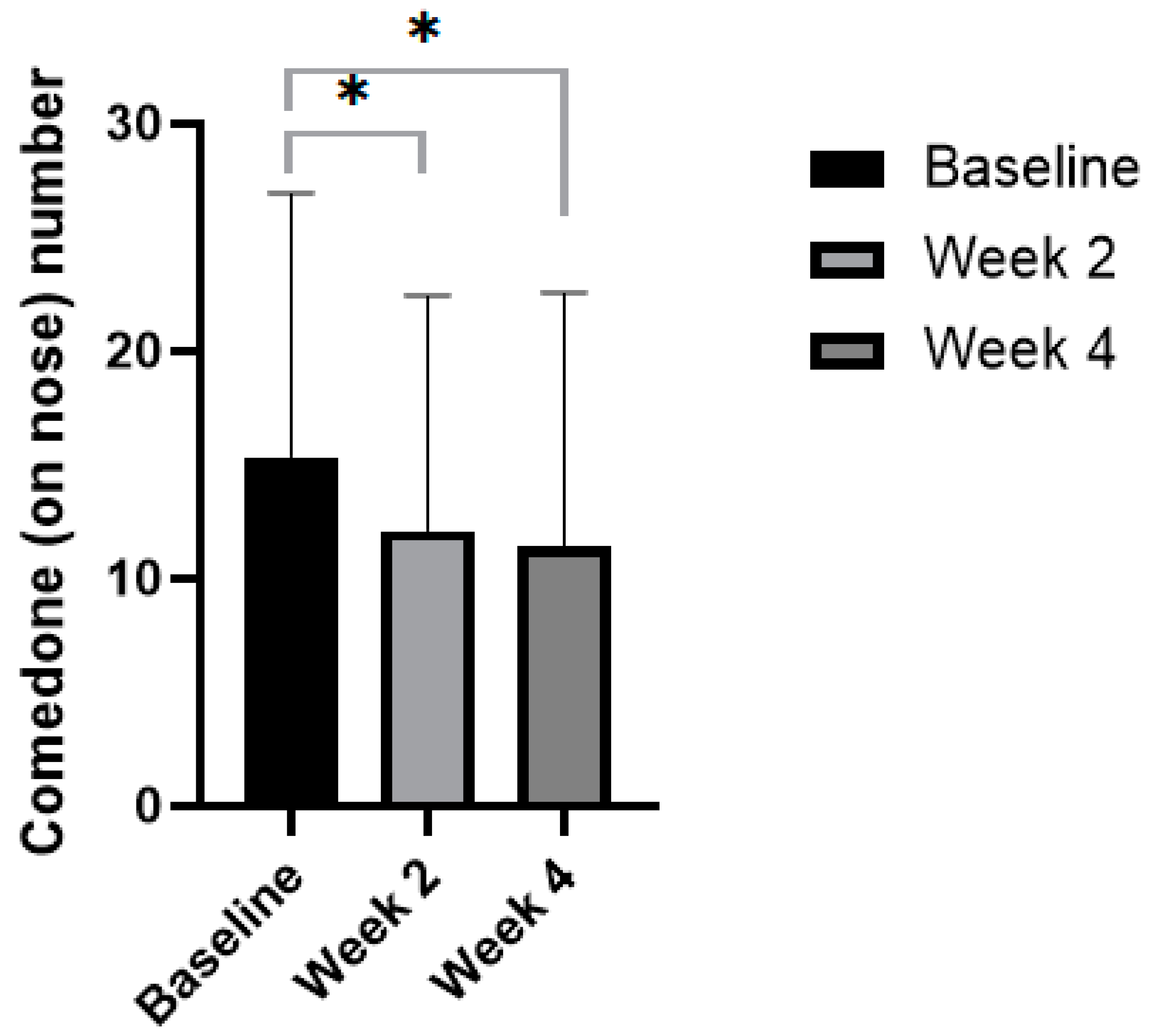
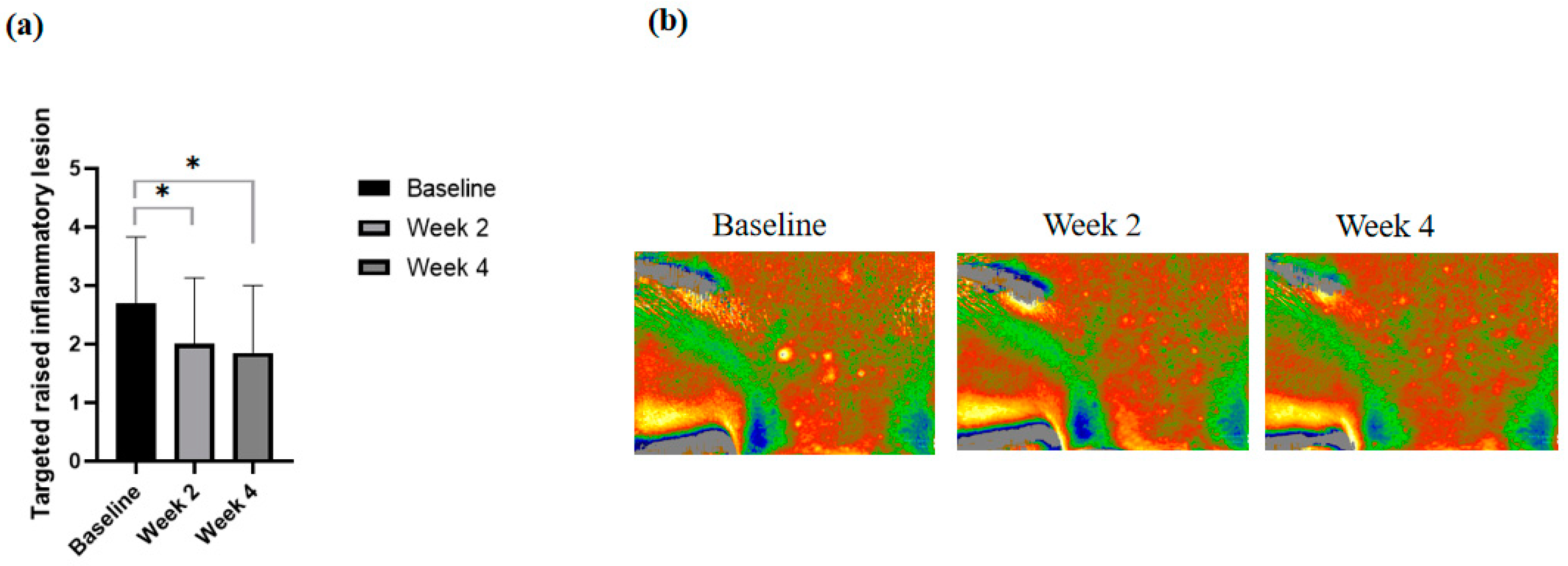

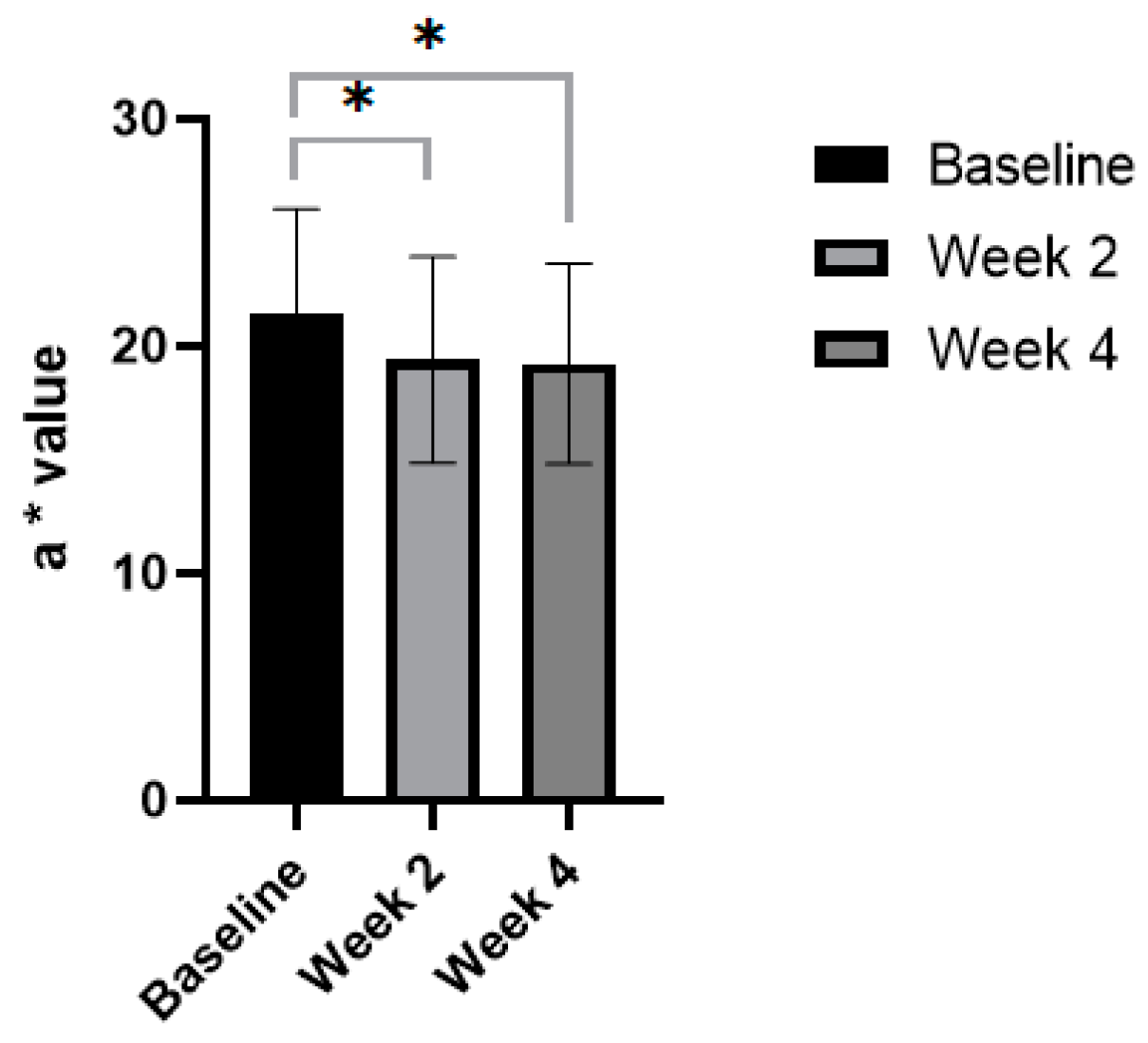
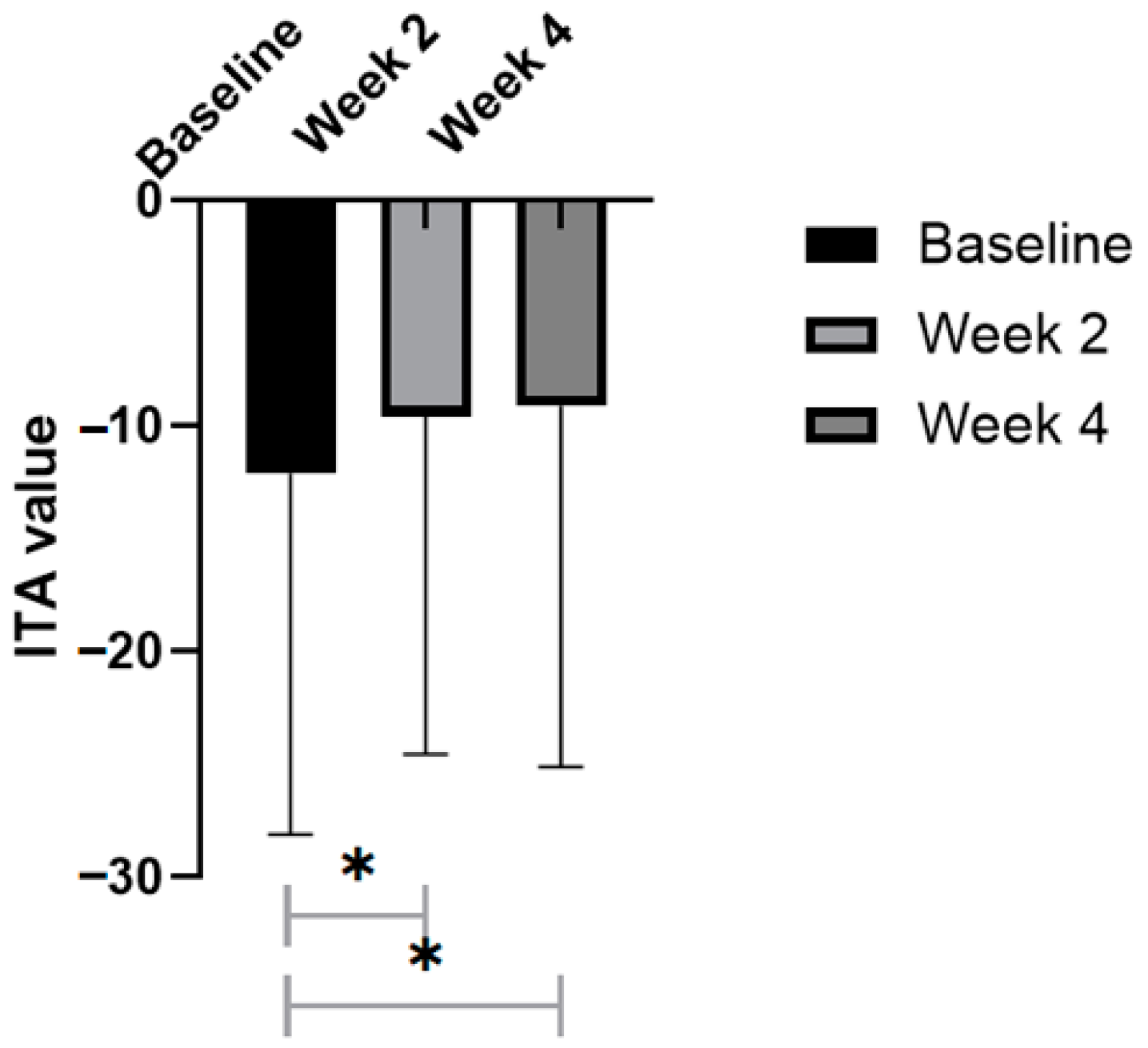
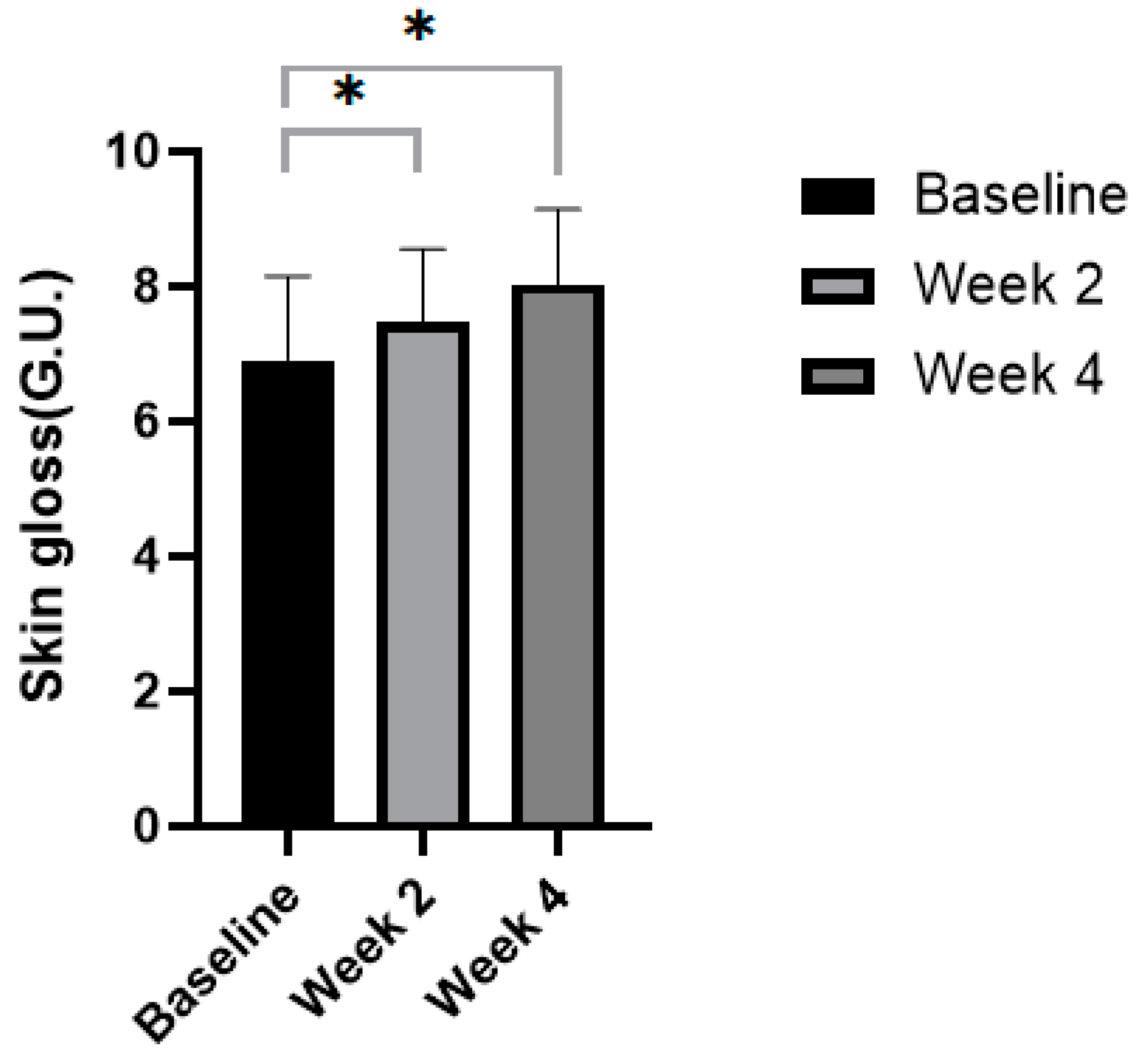
| Parameter | Mean | Rate of Change | Significant Difference Compared with D0 | ||||
|---|---|---|---|---|---|---|---|
| Baseline | Week 2 | Week 4 | Week 2 | Week 4 | Week 2 | Week 4 | |
| Papule count | 6.09 | 4.86 | 4.33 | −20.23% | −29.01% | 0.035 | 0.001 |
| Pustules count | 0.88 | 0.63 | 0.53 | −28.95% | −39.47% | 0.27 | 0.198 |
| Total inflammatory lesion count | 6.98 | 5.49 | 4.86 | −21.33% | −30.33% | 0.015 | <0.001 |
| Open comedone count (on face) | 1.23 | 0.74 | 0.72 | −39.62% | −41.51% | 0.018 | 0.016 |
| Closed comedone count | 18.05 | 13.53 | 14.19 | −25.00% | −21.39% | <0.001 | 0.002 |
| Total non-inflammatory lesion count | 19.28 | 14.28 | 14.91 | −25.93% | −22.68% | <0.001 | 0.001 |
| Total lesion count | 26.26 | 19.77 | 14.88 | −18.73% | −23.17% | <0.001 | <0.001 |
Disclaimer/Publisher’s Note: The statements, opinions and data contained in all publications are solely those of the individual author(s) and contributor(s) and not of MDPI and/or the editor(s). MDPI and/or the editor(s) disclaim responsibility for any injury to people or property resulting from any ideas, methods, instructions or products referred to in the content. |
© 2025 by the authors. Licensee MDPI, Basel, Switzerland. This article is an open access article distributed under the terms and conditions of the Creative Commons Attribution (CC BY) license (https://creativecommons.org/licenses/by/4.0/).
Share and Cite
Kuai, Z.; Wang, W.; Yang, J.; He, X.; Yi, Y.; Wang, H.; Zheng, Y.; Ai, Y. The Anti-Acne and Reduction of Hyperpigmentation Effects of Products Containing Retinol, Niacinamide, Ceramides, and Dipotassium Glycyrrhizinate in Chinese Women. Cosmetics 2025, 12, 69. https://doi.org/10.3390/cosmetics12020069
Kuai Z, Wang W, Yang J, He X, Yi Y, Wang H, Zheng Y, Ai Y. The Anti-Acne and Reduction of Hyperpigmentation Effects of Products Containing Retinol, Niacinamide, Ceramides, and Dipotassium Glycyrrhizinate in Chinese Women. Cosmetics. 2025; 12(2):69. https://doi.org/10.3390/cosmetics12020069
Chicago/Turabian StyleKuai, Zheng, Wenna Wang, Jiahong Yang, Xiaofeng He, Yi Yi, Hequn Wang, Yijie Zheng, and Yunfei Ai. 2025. "The Anti-Acne and Reduction of Hyperpigmentation Effects of Products Containing Retinol, Niacinamide, Ceramides, and Dipotassium Glycyrrhizinate in Chinese Women" Cosmetics 12, no. 2: 69. https://doi.org/10.3390/cosmetics12020069
APA StyleKuai, Z., Wang, W., Yang, J., He, X., Yi, Y., Wang, H., Zheng, Y., & Ai, Y. (2025). The Anti-Acne and Reduction of Hyperpigmentation Effects of Products Containing Retinol, Niacinamide, Ceramides, and Dipotassium Glycyrrhizinate in Chinese Women. Cosmetics, 12(2), 69. https://doi.org/10.3390/cosmetics12020069






